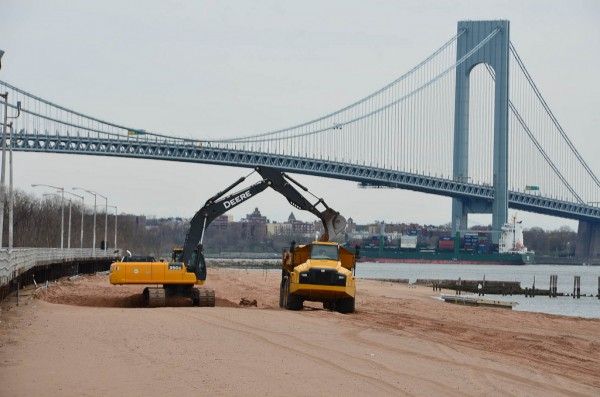
JP Morgan Settles for $5.1B | Poor Housing Bad for Children | NYC Plays Catch-Up Post Sandy

Rebuilding a Beach on Staten Island (credit: Sandra Foyt, Flickr)
- JPMorgan Chase settles with housing regulator for $5.1 billion. JPMorgan Chase announced that it reached a $5.1 billion settlement with the Federal Housing Finance Agency, which is a conservator for the mortgage giants Freddie Mac and Fannie Mae.This deal is one part of a greater settlement said to be worth $13 billion. The bank has reached a tentative deal that would settle civil charges related to wrongdoing by some of its units just before and during the housing crisis.
- How crummy, run-down housing harms the children who live in it. The attention raised by the mortgage crisis and the foreclosure crisis really missed a lot of central aspects of housing that are likely to be important for children,’ says Rebekah Levine Coley, a professor in the Lynch School of Education at Boston College. Notably, it’s the quality of housing, the presence of peeling paint or cockroaches, broken appliances or damaged walls, that most strongly predicts a child’s well-being and development.
- Bank’s midlevel executive becomes a new face of the housing crisis. More than five years after the housing bust, the roll call of banking executives who have been blamed by the public for the crisis has grown ever longer. But when it comes to top managers who have been hit with a jury verdict for pushing dubious mortgages, the list is small indeed. The new name added this week was Rebecca S. Mairone, a midlevel executive at Bank of America’s Countrywide mortgage unit, who was held liable by a federal jury in Manhattan for having saddled the housing giants Fannie Mae and Freddie Mac with bad mortgages that resulted in over $1 billion in losses.
- Suddenly housing activity looks bullish again. The quantity and quality of positive, meaningful housing news coming out means housing activity has ramped up to an important level. As a result, it’s appropriate to be bullish and put those recession-based worries behind us. Doing so now gives us a jump on other investors, even those who are feeling generally positive.
- A 140-acre forest is about to materialize in the middle of Detroit. After nearly five years of planning, a large-scale attempt to turn a big chunk of Detroit into an urban forest is now underway. The purchase of more than 1,500 vacant city-owned lots on the city’s lower east side - a total of more than 140 acres - got final approval from Detroit Emergency Manager Kevyn Orr and Michigan Governor Rick Snyder last week.
- Developers, activists team up against Council bill benefitting construction unions. Big real estate developers, affordable housing builders and minority activists are teaming up to fight a Council bill they say will stymie local employment and economic development in the outer boroughs. The bill, known as the Safe Jobs Act, would require all projects receiving $1 million or more in city subsidies or tax benefits to be built using state-certified apprenticeship programs.
- Things are bad for the 15 communities that explored a desperate housing bailout. At least 15 communities around the country that are or have considered seizing homes lag behind on several economic indicators, according to a new Urban Institute report. Each of the cities have at some point turned to the idea of taking ownership of underwater homes through eminent domain - which allows governments to forcibly buy property - and selling them back to homeowners at a deep discount.
- New York has only completed 20 of its 257 post-Sandy tasks. For the vast majority of New York City, the trauma of Hurricane Sandy has passed. Though huge swaths went days without power, weeks without mass transit and months without heat following the storm’s devastating landfall last October, this week’s one-year anniversary finds the city’s most obvious wounds healed and the lion’s share of its day-to-day operations unencumbered. But on the periphery—in the Rockaways, on Staten Island’s South Shore and along Brooklyn’s edges—where the storm surge was highest and the damage greatest, evidence of Sandy still litters the landscape. There are miles of shuttered coastline, building lots specked with rubble, entire neighborhoods without habitable homes and blue tarps flapping like flags of surrender.
- Brilliant map shows when most of the homes in your area were built. This is a fascinating way to visualize when various regions across the U.S. first got developed. Seth Kadish at the blog Vizual Statistix has put together this map showing when the plurality of homes in any given county were built.
- CitiBike signups scarce in poor NYC neighborhoods. A month after the launch, the city crowed that more than 1 million miles had already been pedaled on the royal blue bicycles. By September the number had soared to 7 million miles. And just last week the city’s Department of Transportation Commissioner, Janette Sadik-Khan, noted the program had clocked more than 4.3 million trips. Since Citi Bike started in late May, officials have heralded milestone after milestone to underscore the program’s runaway success. But for all the fanfare, some figures go unmentioned - like the very low Citi Bike participation rate among low-income New Yorkers, and the lack of membership in the outer boroughs.


